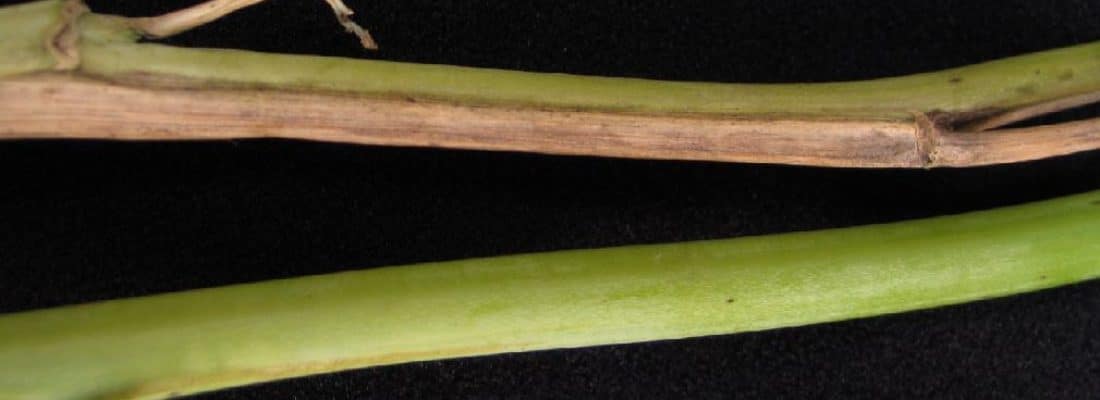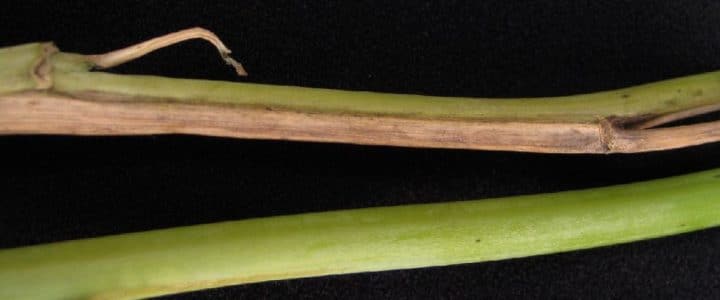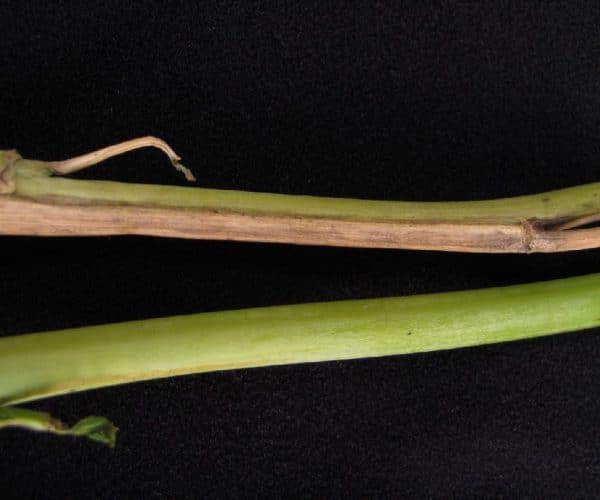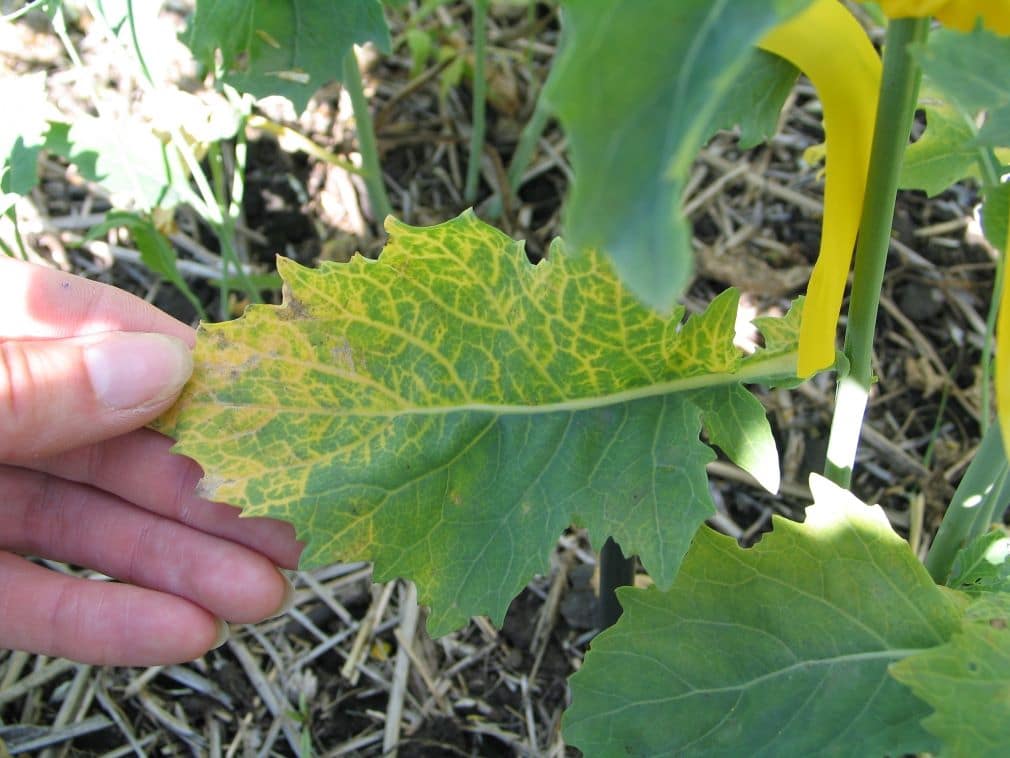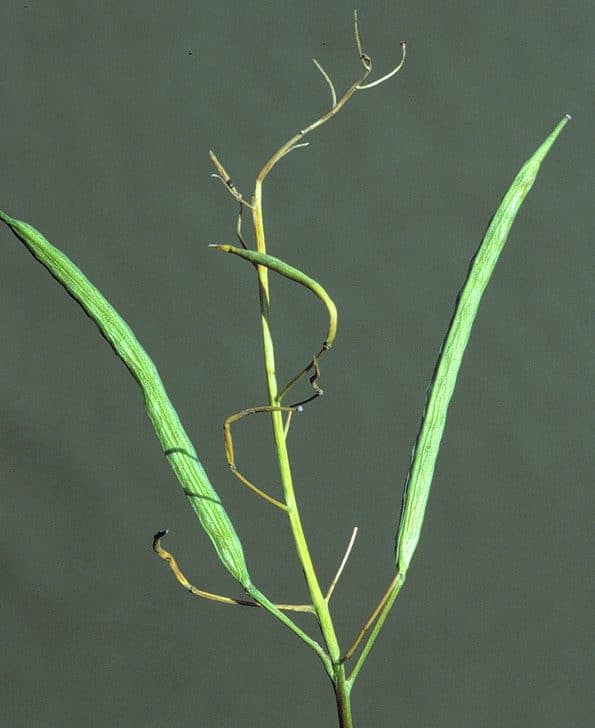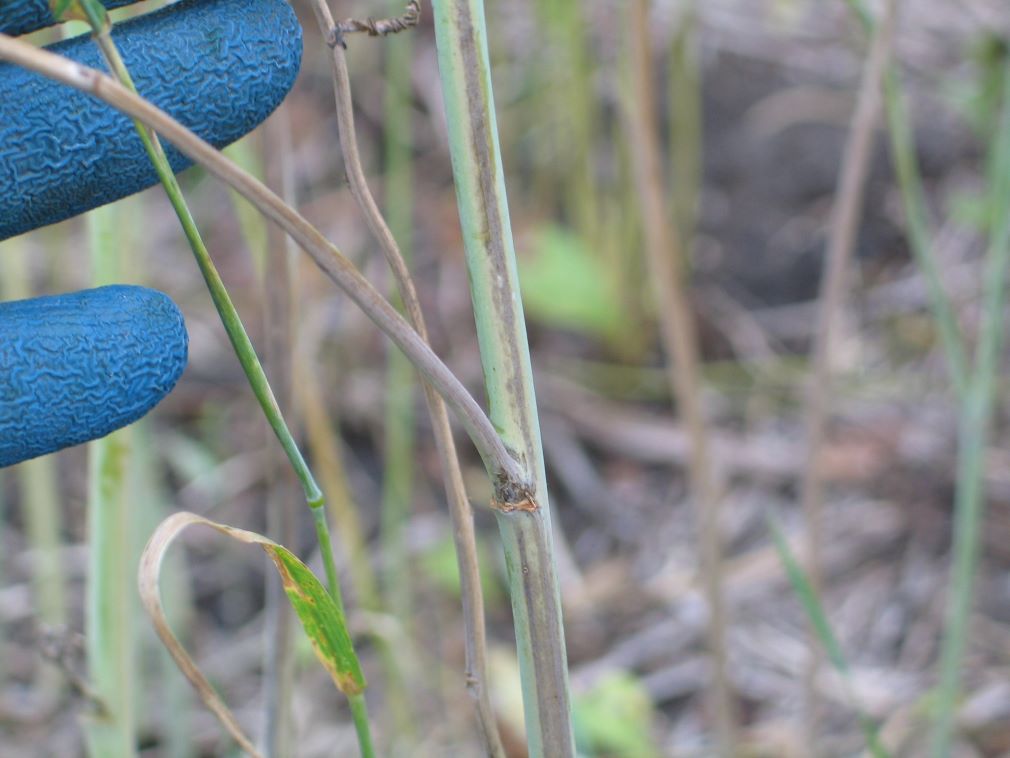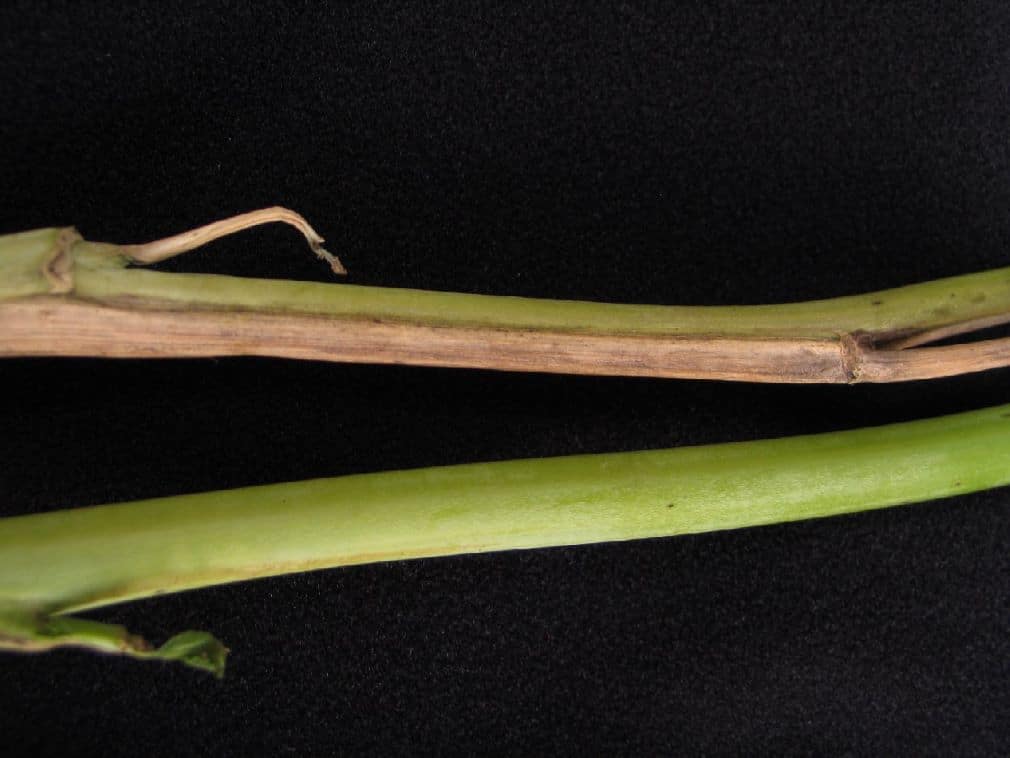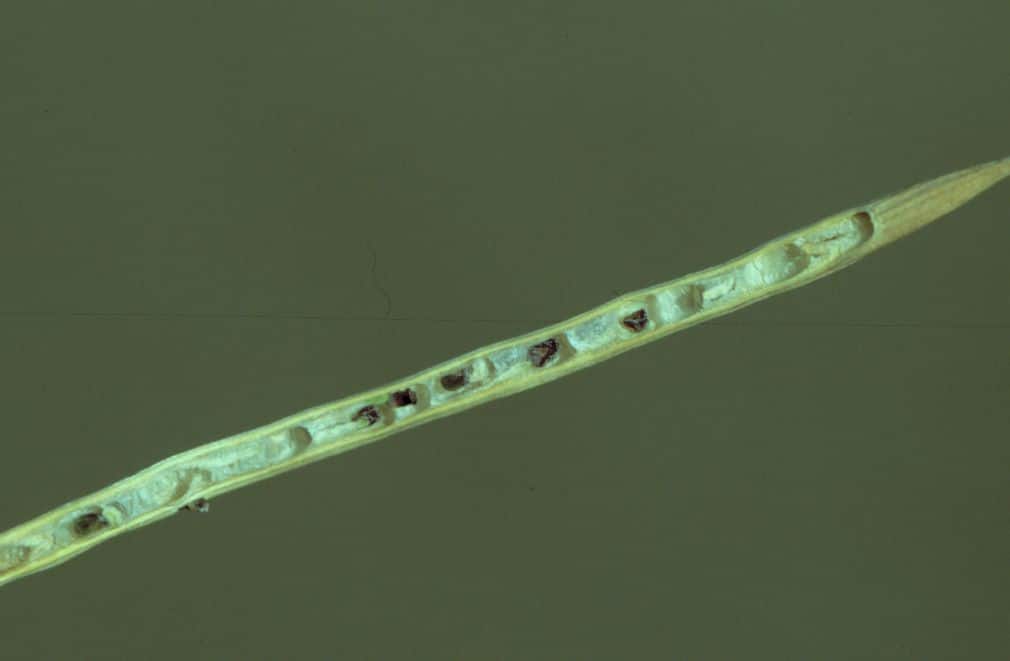Photo credit: Ralph Lange
Fusarium wilt is a fungal disease caused by the pathogenA disease-causing organism (such as a fungus or bacteria). More Fusarium oxysporum that can affect canola. It is not very common due the successful introduction of a resistance gene in the early 2000s.
Conditions which stress the plant, such as limited if moisture, increases the risk of infection. It can cause yellowing, wilting and dark discolouration of the vascular tissue, often occurring only on one side of the stem or on the branches. It can also cause an orange or pink discolouration at the base of the stem and premature death in severely-infected plants.
Overview
Fusarium wilt, a fungal disease of canola, is caused by the pathogenA disease-causing organism (such as a fungus or bacteria). More Fusarium oxysporum f. sp. conglutinans.
Fusarium oxysporum usually winters as soil-borne chlamydospores (thick-walled resting spores) in the soil or on infected crop residues. Two other spore types, macro- and microconidia, are also formed. Spores germinate and penetrate roots directly or through cracks formed by emerging lateral roots. The expanding myceliumMicroscopic fungal filaments More then infects the vascular tissue, which becomes discoloured and blocked. The fungus produces microspores that move up the stem. The blockage of the xylem prevents water movement up the stem, resulting in wilting of the plant. Spores are also formed on aerial plant parts, which fall to the ground and re-infest the soil. Occasionally, seed is infected via the vascular tissue, but usually the seed aborts before this can occur. Fusarium oxysporum is long-lived in the soil with spores remaining over 10 years. The pathogenA disease-causing organism (such as a fungus or bacteria). More moves through the soil by wind or water movement, or on equipment.
Any conditions which stress the plant increase the risk of infection. Fusarium wilt is affected by environmental conditions, primarily soil temperature and moisture. Warm temperatures above 16°C encourage disease development 1. Dry soils are favourable for disease development. Factors that contribute to a reduced rate of root growth increase the plant’s susceptibility to fusarium wilt 2. Early planting in cool, moist soil favors the disease.
Fusarium wilt of canola was first seen in the Peace River region of Alberta in 1999, the first report in North America 3. A widespread fusarium wilt epidemic occurred in 2002. Severely affected crops were found in an area ranging from central Alberta to northeastern Manitoba. Of 52 Brassica napusAlso referred to as Argentine canola, it is the species of canola currently commonly grown in Canada. More fields surveyed in central Alberta during late August, 22 fields showed some level of fusarium wilt. One hundred randomly selected plants were surveyed per field. An average of 17 per cent of plants in these 22 fields was affected. Fusarium wilt incidence in these affected fields ranged from trace to 52% 4
Symptoms
If conditions are moisture limiting, symptoms will be more noticeable and easier to detect. Scout for these symptoms:
• Yellowing, wilting, and dark-brown or black discoloration of the vascular tissue, often occurring only on one side of the stem or on the branches known as unilateral streaking. Some plants may have an orange pink discolouration at the base of the stem. Plants with minor infection may also ripen prematurely and tend to shatter.
• Chlorosis and necrosisA symptom of plant cell or plant tissue death. More of stems, vascular discolouration, poor seed set and premature desiccation.
• Premature death in severely infected plants. Stems and branches turn brown, but plants remain upright with roots intact. No visible lesions are visible on stems or roots. Plants are often stunted and have small pods with no seeds.
To differentiate fusarium wilt from other stem diseases, see this Canola Watch comparison table.
Management
Fusarium wilt is not as common as other canola diseases. All Canadian spring canola cultivarsCultivars are variants in a species developed through the intervention of humans (despite the term 'variety' often being incorrectly used to describe this). Cultivars can be open-pollinated type, hybrid, synthetic, composite, etc. More should be resistant to fusarium wilt with the introduction of a major dominant resistance gene in the early 2000s5. There are no known cultivarsCultivars are variants in a species developed through the intervention of humans (despite the term 'variety' often being incorrectly used to describe this). Cultivars can be open-pollinated type, hybrid, synthetic, composite, etc. More with intermediate resistance. Therefore if intermediate symptoms are observed, these are likely caused by environmental or inoculum load factors.
Other management practices include:
- Plant certified hybrid seed into warm seedbeds which are favourable for rapid emergence.
- Uniform plant stand reduces plant competition for water and extra stressors.
- Lengthen crop rotation to non-host crops or avoid fields with a history of fusarium wilt 6.
Fusarium species
The genus Fusarium is diverse containing many pathogenic species that can cause plant diseases such as wilts and root rots 7. The fungus occurs globally with F. oxysporum being one of the most variable species within the genus 8.
Diseases caused by Fusarium spp. in canola include fusarium root rot, fusarium seedling blight, and fusarium wilt.
In a 2014 study, the predominant Fusarium sp. isolated from the sampled canola fields was F. acuminatum 9. These results suggest that fusarium seedling blight and root rot may now be more important diseases of canola in Alberta than fusarium wilt, which could reflect the widespread cropping of canola cultivarsCultivars are variants in a species developed through the intervention of humans (despite the term 'variety' often being incorrectly used to describe this). Cultivars can be open-pollinated type, hybrid, synthetic, composite, etc. More with effective resistance against the latter.
Learn more about Fusarium in Root rots and Seedling disease complex sections.
Footnotes
- Daly, P., Tomkins, & B., Rural Industries Research and Development Corporation (Canberra, Australia). 1997. Production and postharvest handling of Chinese cabbage (Brassica rapaAlso referred to as Polish canola, it is the less commonly grown species of canola currently grown in Canada. More var. pekinensis): A review of literature. Rural Ind. Res. Dev. Corp. Barton ACT 1997. 97, 32–35[↩]
- Kochman, J. 2007. Contingency Plan – Fusarium wilt of canola. Plant Health Australia. Retrieved from https://www.planthealthaustralia.com.au/wp-content/uploads/2013/03/Fusarium-wilt-of-canola-CP-2008.pdf[↩]
- Lange, R.M., Harrison, L.M., Hall, M., MacDonald, K., & Kharbanda, P.D. 2001. The first report of fusarium wilt of canola in Alberta, 1999. Abstracts, Alberta Regional Meeting, The Canadian Phytopathological Society 1999 in Canadian Journal of Plant Pathology 23: 185[↩]
- Lange, R. M., Gossmann, M., & Büttner, C. 2007. Yield loss in susceptible cultivarsCultivars are variants in a species developed through the intervention of humans (despite the term 'variety' often being incorrectly used to describe this). Cultivars can be open-pollinated type, hybrid, synthetic, composite, etc. More of spring rapeseed due to Fusarium wilt caused by Fusarium oxysporum. Commun. Agric. Appl. Biol. Sci. 72, 723-734.[↩]
- Rahman, H., & Franke, C. 2019. Association of fusarium wilt susceptibility with clubroot resistance derived from winter Brassica napusAlso referred to as Argentine canola, it is the species of canola currently commonly grown in Canada. More L. ‘Mendel’, Canadian Journal of Plant Pathology, 41(1), 60-64, https://doi.org/10.1080/07060661.2018.1505780[↩]
- Schwartz, H.F., & Gent, D.H. 2004. High Plains IPM Guide, Canola and Mustard: Fusarium Wilt. University of Wyoming, University of Nebraska, Colorado State University and Montana State University. Retrieved from https://bugwoodcloud.org/bugwoodwiki/FusariumWilt-CanolaMustard.pdf[↩]
- Beckman, C.H. 1987. The nature of wilt diseases of plants. American Phytopathology Society Press[↩]
- Burgess, L.W., Summerell B.A., Bullock S., Gott K.P., &Backhouse, D. 1994. Laboratory Manual for Fusarium Research 3rd Edition. University of Sydney, NSW, Australia[↩]
- Chen, Y., Zhou, Q., Strelkov, S. E., & Hwang, S.F. 2014. Genetic diversity and aggressiveness of Fusarium spp. isolated from canola in Alberta, Canada. Plant Dis. 98:727-738[↩]
